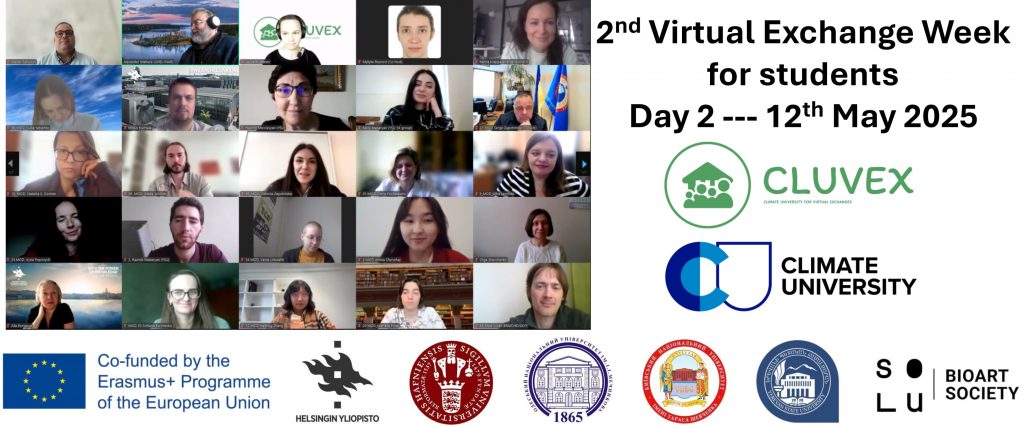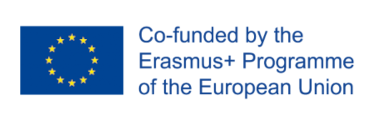The 2nd day, 13th May 2025, of the CLUVEX 2nd Virtual Exchange (VE) Week successfully completed. The VE Week is hosted by Maher Sahyoun from the University of Copenhagen (UCPH), Denmark and Mykota Rozvod from the Mechnikov National University (ONU), Ukraine.

On 13th May, on the second day of the VE Week, about 180 participants attended in Zoom. The Poll of the day (multiple options to select were possible) showed that participants’ expectations for this VE Week included: (i) to meet other students – 44%, (ii) to learn more on climate change – 70%; (iii) to get credits – 31%, (iv) to get international experience – 64%, (v) to have a positive impact on the world – 46%. As seen, the most of the expectations were directed at “to learn more on climate” (70%) and “to get international experience” (64%).
The simple tool “ERA-5 Past Climate Explorer (PCE)” (https://era5.lobelia.earth/en) was introduced and demonstrated by Dr. Alexander Mahura, Univ Helsinki. This tool is used to visualize historical climate statistics for any geographical location around the globe. It is possible, to click anywhere on the interactive map or search for a city to explore the typical monthly climate and discover how the climate has changed over the past years. And it is driven by ERA5 (ECMWF Reanalysis v5) – the 5th generation ECMWF (European Centre for Medium-Range Weather Forecasts) atmospheric reanalysis of the global climate. The tool is user-friendly with a possibility to select relevant parameters and to generate location-specific climate statistics. Among options (aggregation period: average “year” and average “month”) are average, maximum, and minimum air temperatures; frost days and warm nights; precipitation; rainy, heavy rainy, and very heavy rainy days; relative humidity; average wind speed and wind gusts; cloud cover.
This tool, the ERA-5 Past Climate Explorer (PCE), as well as other tools – the Shared Socioeconomic Pathways (SSPs) and the IPCC Web-based Atlas – to be presented on the 3rd and 4th days of the VE Week to be actively used by participants in the preparing the Individual/ Personal and Collaborative/ Joint Climate Horizon exercises during the VE Week.
The CLUVEX Climate Horizon exercise was introduced in more details by Dr. Laura Riuttanen, Univ Helsinki. The focus is that throughout the VE Week, students will draft Individual Climate Horizon that describes a hopeful state of future from a climate change perspective. For that they will use the delivered lectures, demonstrated tools and group discussions as reference and inspiration for Climate Horizon exercise development. On the final day, 16th May, students in each group will present own developed Climate Horizons to members of own group. Finally, the group’s Collaborative Climate Horizon will be presented to all participants of the VE Week. To achieve it, 3 approaches are taken: (1) utilizing tools for climate related data visualization, analysis and interpretation; (2) preparing a reflective text (learning diary/letter to own group); and (3) visual reflection using images (e.g., a collage). Several examples (based on different approaches) were shared with participants. Importance of active usage of the Miro-board by groups was stressed for more effective and productive work on Climate Horizon exercises.
After the demonstration of the ERA-5 Past Climate Explorer tool and more detailed explanation of the Climate Horizon exercise, the VE Week participants were redistributed again into the same small groups (with the moderator) in zoom break-out-rooms as on the first day to continue during 2 hours online discussions, practicing with the tool demonstrated, independently working on individual/ personal Climate Horizon exercise as well started discussions on collaborative/ joint Climate Horizon.
It should be noted that two things are at the heart of the CLUVEX Virtual Exchange concept. CLUVEX/We want to bring together students from different backgrounds to discuss climate-related issues. The study credit (ECTS) is an important earned achievement for many students, which we hope to motivate them to participate in this new type of course, where collaboration and joint practice are at the heart.
See participants of the 2nd Day of the 2nd VE Week.
If you are interested in further details of the CLUVEX project, please, contact the CLUVEX team members.
If you are interested to participate the project, please leave your own contact information here and we will get back to you.
